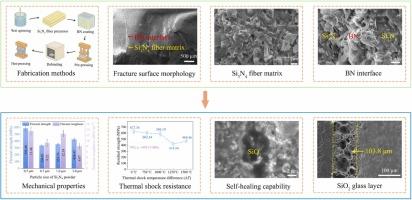优化氮化硅纤维和氮化硼界面,提高氮化硅/氮化硼复合材料的力学性能和抗热震性
IF 6.3
2区 材料科学
Q2 CHEMISTRY, PHYSICAL
引用次数: 0
摘要
本研究展示了一种通过界面优化和粉末颗粒控制来提高氮化硅/氮化硼复合材料热机械性能的策略方法。通过在BN界面添加MgO烧结添加剂,再配以0.5 μm Si3N4纤维前驱体,实现了具有良好力学性能的完全致密化,密度达到3.19 g·cm-3,抗弯强度达到627.36 MPa,断裂韧性达到13.48 MPa·m1/2。复合材料表现出优异的抗热冲击性能,在1000℃热冲击后保持586.19 MPa(93.44%保留率),这是由于原位形成的连续SiO2玻璃屏障有效地防止了氧化。有趣的是,随着ΔT的增加,残余强度呈现先减小后增大的趋势。在ΔT=1500℃时,复合材料的残余强度为469.46 MPa(保留率为74.83%),通过玻璃相的粘性流动实现自修复机制,优于传统的单片陶瓷。结合断口形貌的显微组织演化分析建立了界面、力学性能和抗热震性能之间的直接关联。这些发现为设计具有优异抗热冲击性能的超高温结构复合材料提供了基础见解。本文章由计算机程序翻译,如有差异,请以英文原文为准。

Optimization of Si3N4 fiber and BN interface for high mechanical properties and thermal-shock resistance of Si3N4/BN composites
This work demonstrates a strategic approach to enhance the thermomechanical performance of Si3N4/BN composites through interface optimization and control of powder particles. By adding the MgO sintering additive at BN interfaces coupled with 0.5 μm Si3N4 fiber precursor, we achieved full densification with mechanical properties, attaining a density of 3.19 g·cm-3, the remarkable flexural strength of 627.36 MPa, and fracture toughness of 13.48 MPa·m1/2. The composites exhibit exceptional thermal shock resistance, retaining 586.19 MPa (93.44% retention) after 1000 ℃ thermal shocking, facilitated by in situ formation of a continuous SiO2 glass barrier that effectively prevents oxidation. Intriguingly, the residual strength shows a trend of first decreasing and then increasing with the increase of ΔT. At ΔT=1500 ℃, the composite maintains the residual strength of 469.46 MPa (74.83% retention), outperforming conventional monolithic ceramics through a self-healing mechanism enabled by viscous flow of the glass phase. Microstructural evolution analysis coupled with fracture morphology establishes direct correlations between the interface, mechanical properties, and thermal-shock resistance. These findings provide fundamental insights into designing composites with excellent thermal-shock resistance for ultrahigh-temperature structural applications.
求助全文
通过发布文献求助,成功后即可免费获取论文全文。
去求助
来源期刊

Journal of Alloys and Compounds
工程技术-材料科学:综合
CiteScore
11.10
自引率
14.50%
发文量
5146
审稿时长
67 days
期刊介绍:
The Journal of Alloys and Compounds is intended to serve as an international medium for the publication of work on solid materials comprising compounds as well as alloys. Its great strength lies in the diversity of discipline which it encompasses, drawing together results from materials science, solid-state chemistry and physics.
 求助内容:
求助内容: 应助结果提醒方式:
应助结果提醒方式:


